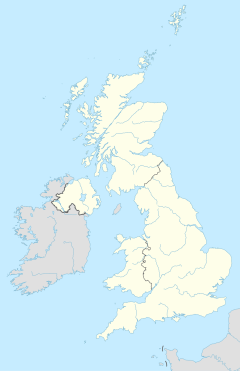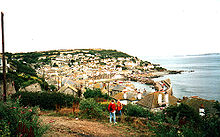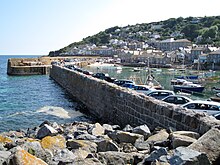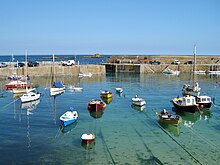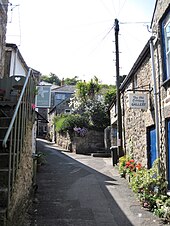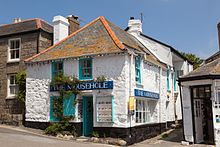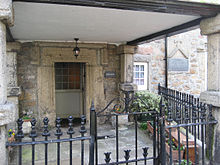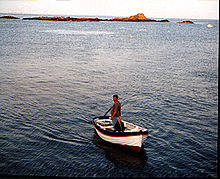Mousehole
|
Mousehole Cornish Porthynys |
|||
|---|---|---|---|
|
|||
| Coordinates | 50 ° 5 ′ N , 5 ° 32 ′ W | ||
|
|
|||
| Residents | 850 | ||
| administration | |||
| Post town | PENZANCE | ||
| ZIP code section | TR19 | ||
| prefix | 01736 | ||
| region | South West England | ||
| Ceremonial county | Cornwall | ||
| Website: Penzance | |||
Mousehole [ ˈmaʊzəl ] ( Cornish Porthynys or Porth Enys , "island port") is a village with about 850 inhabitants in south-west England ( Great Britain ). It is located on the southwestern tip of Britain in the former District Penwith the county Cornwall between Penzance and Land's End , embedded in a wide bay of the southern English coast. Administratively, Mousehole is one of the five boroughs of Penzance.
history
Mousehole has a long history that dates back to 400 BC. Began with the construction of the southern harbor wall. For many years in the early Christian period this was a navigational aid for pilgrim ships to Rome . As early as 1393 a breakwater was built in front of the entrance to the harbor to protect the village. A second breakwater was added later.
At first the village was called Porth Enys (island port). Only at a later point in time was the place renamed Mousehole . The origin of the name is still a mystery. It is believed that the name derives from the Cornish word Mowesheyl , which means something like "at the mouth of the river of the young women". However, some attempts at explanation also refer to the appearance of the small harbor or a cave near the village.
In any case, Mousehole became an important port in Mount's Bay in the centuries that followed , until the ports of Penzance and Newlyn grew steadily in the 16th century. Nevertheless, the port of Mouseholes became more and more important as a fishing port. Regular fairs and weekly markets enlivened the emerging village back then. From 1292 a market was allowed to be held every Thursday and a three-day fair for the St. Barnabas Festival . From 1313 until the Anglo-Spanish War, a seven-day fair was allowed for the St. Bartholomew Festival .
Gradually, the harbor walls were enlarged to protect the village from storm surges . Even today, the entrance to the port can be closed with thick wooden beams to protect it from the terrible winter storms. Approx. A new quay was built in 1392 , which was expanded in 1422 and later in 1870 and repaired in 1435. Around 1395 a storm surge destroyed a chapel that stood on the edge of the waterfront near Mousehole. For this reason, a small chapel dedicated to St. Mary was rebuilt in the town center around 1414 .
During the Anglo-Spanish War, the port of Mousehole was taken by 200 Spaniards from the water in 1595, in order to bring their soldiers ashore from there, who were supposed to reach the interior via Cornwall . After the landing of four galleys , in order to break resistance, Mousehole as well as the neighboring town of Paul, which belongs to the community, was completely burned down. While all the residents fled the village, only one man, Jenkyn Keigwin, defended his house. Although he saved the building, he was shot by a Spaniard as a result. It was the only house that did not burn and it became the Keigwin Arms pub after the village was rebuilt. Today, however, it is again privately owned and inhabited.
At that time, English was not the mother tongue in Cornwall , but Cornish , a Celtic language closely related to Welsh and Breton . It was not until the 17th century that the English language replaced the previously traditional Cornish. The last known person who could speak fluent Cornish as his mother tongue is said to have been Dolly Pentreath from Mousehole . She died in 1777 and in 1860 received a memorial from Prince Louis Bonaparte in the church in the neighborhood of Paul.
After six fishermen from Mousehole rescued the crew of the stranded cargo ship Baltic in 1907, a station of the Royal National Lifeboat Institution was established there . The station was moved to Penlee Point about half a mile north of the harbor in 1913 , but was still occupied by Mousehole residents. When the Ansgir stranded on the rocky coast at Penzer Point about 1.5 km south of Mousehole on December 1, 1920 , her crew was rescued by the station's men. On December 19, 1981, the Penlee lifeboat Solomom Browne sank during a Union Star rescue attempt . The entire rescue team drowned. The station was then closed.
Traditions and Legends
A well-known tradition is the Tom Bawcock's Eve festival . According to legend, in the distant past long, harsh winter weather prevented Mousehole fishermen from going out to fish. Food supplies were quickly running low and famine loomed in the village. The brave fisherman Tom Bawcock dared to do it anyway and came back with a catch that was enough to feed the villagers. In his honor, a huge fish pie , the so-called Stargazy Pie , is baked every year on December 23rd as part of a large village festival and served in The Ship Inn on the pier.
As early as the end of September each year, the village begins preparing the Christmas lights, which are well worth seeing . For almost 40 years the festival has been opened with the Mousehole male choir and a brass band. Brightly shining and colorful lights and pictures adorn the village along the harbor wall until a week after the New Year. The proceeds go to a charitable cause. Only on December 19th between 8:00 p.m. and 9:00 p.m. do the lights go out in memory of the drowned Solomon Browne lifeboat crew.
Immediately in front of the harbor wall is the small rocky island of St. Clement's Isle in the sea. It is said that an ancient hermit lived here a long time ago.
The Sea Salt & Sail Festival is held in Mousehole every two years. The purpose of this maritime festival is to bring people closer to the old fishing trade. Historical craftsmanship, fishing centuries ago and old ways of life are taught. In addition to the sporty sailing activities and informative, craft presentations, fun is not neglected. Every event is accompanied by shows of all kinds.
Mousehole today
The place has not been changed by major settlements and industrialization in the last few decades. You can still find the old village charm that attracts many tourists in every season. Mousehole now boasts of being one of the most beautiful fishing villages in Britain.
If you come to Mousehole from Penzance , you can reach the small fishing port in the town center through narrow and winding streets. All around there are many narrow and steep alleys with neat old houses built from granite stone and slate, which look down on the port area and the Atlantic Ocean. Today you will not only find fishing boats here, but also sailboats and yachts of holidaymakers.
The foothills of the Gulf Stream create a kind of mild, subtropical climate in Mount's Bay , in which exotic plants also thrive. This natural exoticism can also be found in Mousehole , where the visitor z. B. wondering about palm trees.
The English poet Dylan Thomas , who spent his honeymoon there in 1938, describes the place as "The loveliest village in England".
The name "Mousehole"
There is no consensus on what the name "Mousehole" means or where it came from. Literally translated it means "mouse hole", but it is not clear whether the literal translation corresponds to the true meaning. There is a presumption that the name refers to a large cave near the place. On the other hand, it could also be the modern spelling of the Cornish name “Moeshayle”, which means “Mädchenbach”.
Attractions
First and foremost, of course, is the port, which makes Mousehole a tourist attraction. It is one of the oldest British fishing ports. The Christmas Lights around Christmas and the Tom Bawcock's Eve Festival on December 23rd are worth seeing.
In addition to the village of Mousehole itself, you shouldn't miss the oldest house in town, the "Keigwin Arms", which was built in the 14th century and was the only house to survive the fire in 1595. "The Ship Inn" is a pub with a view of the harbor located directly on the pier and is known beyond the borders of Mousehole.
About 150 meters south of the village center, at the foot of a mountain, there is a large cave known as "The Mouse Hole", the entrance area of which is about 15 meters high and 10 meters wide. Then the cave leads approx. 45 meters into the cliff. According to one theory, this cave gave the place its name.
For experienced and good swimmers, the small rock island St. Clement's Isle is recommended, which is about 800 meters from the mainland. The Wild Bird Hospital and bird sanctuary in Mousehole helps over 1500 wild birds annually and has become a tourist magnet.
supporting documents
- ↑ population
- ^ Mousehole Harbor Authority, History of the Place
- ↑ myCornwall.com, History of the Place


